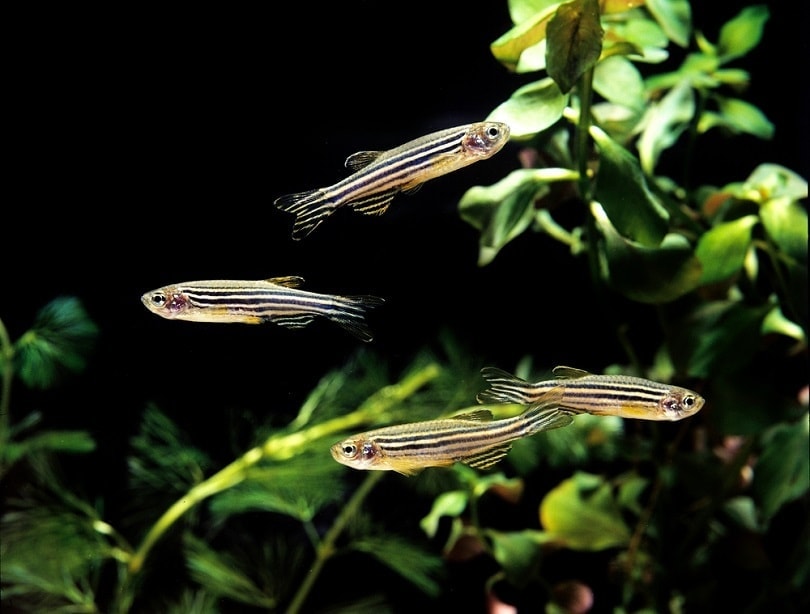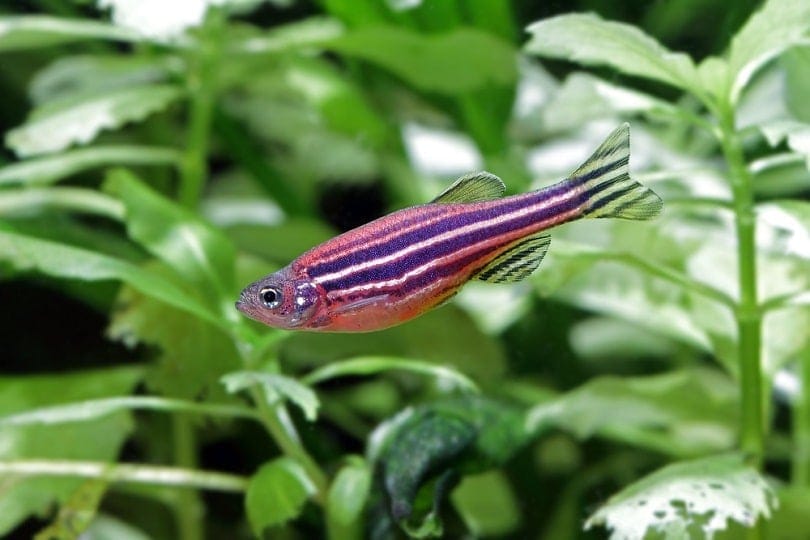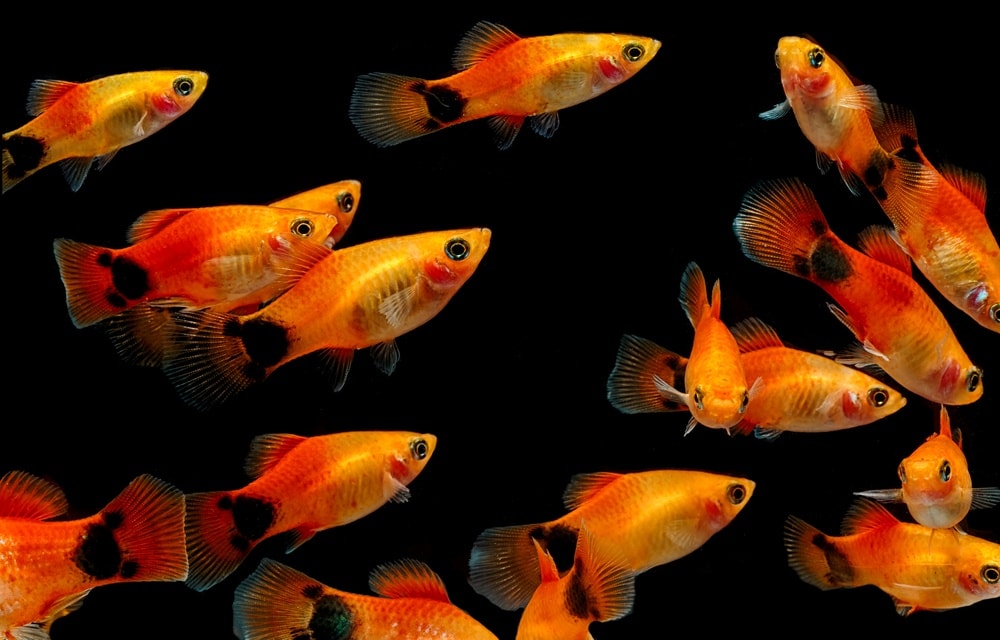Zebra Danio (Zebrafish): Vet-Approved Care, Pictures, Food, Lifespan & Tank Setup Info

Updated on

The zebrafish, better known as the zebra danio (Danio rerio) is a hardy freshwater fish that is extremely popular in tropical aquariums (though they are also able to thrive in subtropical conditions). These fish can form large shoals and come in a variety of color morphs. They are one of the most popular shoaling fish available and have been selectively bred and genetically modified to change their appearance.
They are perfect for community tanks because of their peaceful disposition and are an excellent choice for a beginner who is wanting to start their first tropical aquarium . These fish will add a dash of color and energy to an aquarium. This article will show you every care aspect the zebra danio requires.
Quick Facts about Zebra Danio
| Species Name: | Danio rerio |
| Family: | Cyprinidae |
| Care Level: | Easy, beginner-friendly |
| Temperature: | 18 – 24°C (64.4 – 75 °F) |
| Temperament: | Peaceful |
| Color Form: | Silver, blue, golden, albino, Glo morphs |
| Lifespan: | 3.5 years (average estimate), 5.5 years (record) |
| Size: | 2 inches (5 centimeters) as adults |
| Diet: | Omnivore |
| Minimum Tank Size: | 30 gallons for 10-15 danios |
| Tank Set-Up: | Planted, freshwater |
| Compatibility: | Peaceful communities |
Zebra Danio Overview
Zebra danios are a species of fish from the Cyprinidae family. These fish are widely distributed from Nepal down to India. This species is found in the tropical and subtropical waters in Bangladesh, India, and Pakistan. They are a loved freshwater shoaling fish for many different reasons.
You will find them in nearly every pet store that stocks fish. Alongside being incredibly hardy, they are also easy to care for and are perfect for community tanks because of their peaceful nature. They can live for up to 3.5 years if they are cared for properly. The verified record lifespan of a pet zebra danio is 5.5 years 1.
A zebra danio may be hardy enough to tolerate a wide range of conditions, but bad care can cause them to deteriorate quite fast. These fish are also commonly used as test subjects for various research studies. A fun fact is that humans share 70% of their genes with these fish!
As scientific research models, they have helped a lot of scientists further their knowledge of fish-related medications and housing ideas. They are found in various habitats, including slow-moving rivers and streams when they are in a dry season. They will then live in ponds when the flooding season is at its peak. In the monsoon season, the fish live in rice paddies.

How Much Do Zebra Danios Cost?
Since these fish are in high demand, they will be relatively inexpensive. You should not expect to pay much for a natural-colored species. One zebra danio should cost roughly $1 to $3. You will, however, pay more for the glo fish versions. These fish are genetically modified and do not survive in the wild.
If you choose to purchase them from an online breeder, you can expect to pay $2 per natural-colored danio (silver or blue striped) and $5 for a glo danio. Shipping will also be added to the total price if you purchase a group online. Since they require large groups to be happy, you can expect to pay up to $30 for a large school.
Typical Behavior & Temperament
Zebra danios are active fish that stay towards the mid-ground of your tank. They are also commonly seen swimming near the surface, where they wait for food. Different morphs of this fish readily shoal with each other, allowing mixing and matching with their different color and pattern morphs (for example, leopard and zebra danios readily shoal together).
At least six danios are required to form a successful school. If your danios are not part of a large group, their temperament can quickly change from peaceful to semi-aggressive. They can fin nip their tank mates if they are kept in a small group or a tank that is too small for them (such behavior is attributed to the stress of not being in a shoal).

Appearance & Varieties
These fish grow to a maximum size of 2 inches. They can be sexed; however, this is slightly tricky in juveniles. Adult males are somewhat torpedo-shaped and have alternating blue and gold stripes (for the wild type morph). Females, on the other hand, have a larger, whiter belly and silver stripes instead of gold.
These fish come in fun colors like the glo danio, albino, red, pink, peach, and green. This makes them pop out in an aquarium with their vivid coloration. There is also a fin variation called the long-finned zebra danio. These fish will have long-flowing fins, especially by the rear. The long-finned danios do not live in the wild and were specifically bred to have longer fins than their wild varieties.
There is also a fancy coloration called the golden morph zebra danio. These fish are golden orange with transparent fins.
The popularity of these fish has encouraged breeders to produce a variety of different colors. Some will look so bright that they seem to glow. Such fish are trade named Glofish, and they are the first fish to be sold as genetically modified organisms.
How to Take Care of Zebra Danios
Habitat, Tank Conditions & Setup
Tank/aquarium size
If you want to keep a school of 10 zebra danios, you will need a tank size of at least 20-30 gallons. The tank should have more length than height and come with a strong lid. Generally speaking, larger tanks are always better and also open the door for the possibility of a community setup, which danios can readily be added to.
Water temperature & pH
They are often referred to as both tropical and subtropical water fish. They are able to successfully live in temperatures ranging from 18 – 24°C (64.4 – 75 °F); however, it is important that the temperature in their aquarium remains stable. Their pH preference is a value between 6.0 to 8.0, with 7.0 being ideal.
Substrate
Since danios are not bottom dwellers, many substrates work well for them. Aquarium sand, gravel, or pebbles are all good options. You can even keep your tank substrate-free, if necessary.
Plants
These fish do not require heavily planted aquariums, but they do appreciate some live ones throughout the tank. They do not hide unless they are ill and will mainly be seen swimming in the middle of the aquarium, where fewer hiding spaces exist. You can grow large-leafed plants to provide your danio with an enriching environment. However, if you find live plants daunting as a beginner, you can opt for artificial silk plants instead.
Lighting
Danios have no specific lighting requirements. If you have no live plants in your aquarium, a standard fluorescent light, left on for around 8 hours per day, will suffice. Alternatively, in such a setup, you can also use the ambient lighting of your room. If you have live plants or fish with specific lighting requirements though, you should cater your lighting to their requirements.
Filtration
These fish appreciate moderately fast currents in the aquarium. This can be achieved by using a good quality filter with a slightly strong output (to mimic a stream of sorts). The filter should be able to filter anywhere from two to five times the amount of water volume in an hour (this is also known as the filter’s rating). Clean water is essential for all fish, and weekly partial water changes should be performed.

Are Zebra Danios Good Tank Mates?
This fish is commonly found in community setups with a variety of peaceful community fish. Avoid placing aggressive fish in the same tank as your danios. Background research should be done to ensure each species of fish is compatible with your danios.
The tank mates should also not be predatory or large enough to be able to fit your danio into their mouth. Fin nippers should also be avoided, especially for the long-finned varieties. You should also avoid keeping danios on their own or in small groups. This will greatly stress them out and likely lead to illness. We have put together a list to give you a basic idea of some good tankmates for your zebra danios.
- Scarlet badis
- Ember tetra
- Honey gourami
- Bengal danio
- Celestial pearl danios
- Rosy barbs
- Dojo Loach
- Bronze cory
- Rummy nose tetra
- Guppies
- Dwarf molly
- Highfin platy
- Green spotted puffer
- Freshwater “sharks” (such as the Rainbow shark or Red-tailed black shark)
- Any cichlids (such as Convicts or Oscars)
- Cichlids
- Arowanas
- Goldfish
- Koi
What to Feed Your Zebra Danio
These fish are omnivores and feed on algae, worms, larvae, and small crustaceans in the wild. As pets, you should try and feed foods that replicate their natural diet. Luckily, most of their wild foods are available at pet stores. Alongside supplements like brine shrimp, daphnia, and worms, you should feed quality commercial freshwater fish food.
Common commercial foods for danios come in the form of small pellets, granules, and flakes. The food should be made for danios and other shoaling fish. They can be fed once or twice a day as juveniles. Adults can be fed once a day or once every other day. These fish also have the ability to go up to 48 hours without being fed as long as they are healthy adults housed in appropriate conditions.
Keeping Your Zebra Danio Healthy
Danios are suited for novice aquarists, but research and basic knowledge of their care are essential. To avoid disease outbreaks, you must ensure the water is kept clean. This can be done by running a good filter in the tank, ensuring it is the correct temperature, and doing frequent water changes. In addition, your fish should only be housed in a cycled aquarium.
Gravel vacuums should also be performed to suck up any debris in the substrate. The water should be dechlorinated, and you must use a liquid testing kit to measure the amount of ammonia, nitrite, and nitrates in the tank’s water. Poor water quality is the main cause of poor health in danios.
By providing your danio with good conditions and meeting the right requirements, you will be rewarded with a healthy danio. Ensure the diet is varied and that you keep no unsuitable tank mates that will induce stress.
Breeding
Since these fish are readily available as pets and very inexpensive, it’s best to not breed them when keeping them as pets. This is because inbreeding these fish has led to multiple genetically weak strains, and many fish develop bent spines as a result of this genetic defect.
Breeding these fish also involves extra aquariums or breeder tanks, as the parents will indiscriminately eat their eggs and young. Therefore, it’s a task best left to professionals.
Conclusion
If you are looking for a colorful shoaling fish that adds vivid colors to your aquarium, look no further than a group of colorful zebra danios. A beginner and experienced fish keeper can both keep this amazing fish if they have the right tank conditions. The tank should be large with suitable tankmates, and the temperature should be suited for the community.
We hope this article has helped you better understand the care zebra danios must receive.
Featured Image Credit: slowmotiongli, Shutterstock














